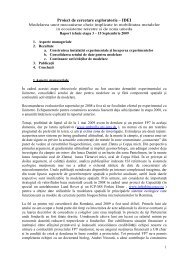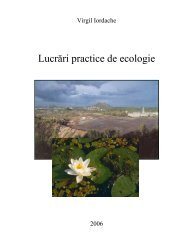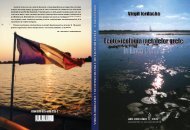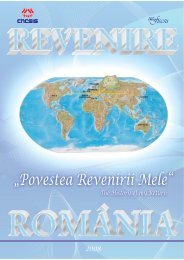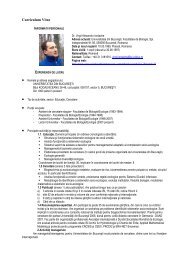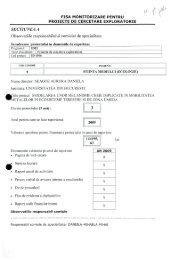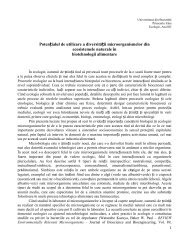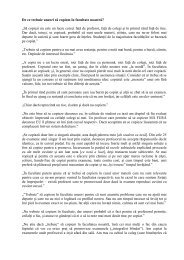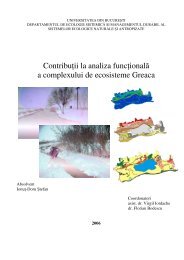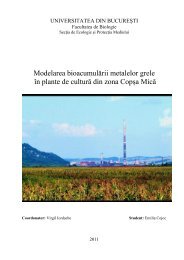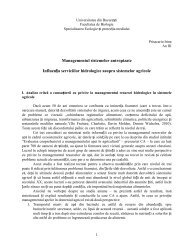PDFCreator, Job 14 - CESEC
PDFCreator, Job 14 - CESEC
PDFCreator, Job 14 - CESEC
- No tags were found...
Create successful ePaper yourself
Turn your PDF publications into a flip-book with our unique Google optimized e-Paper software.
Anal. t. I.D.D.Tulcea, Romaniavol. 10 2004parts of LDF.The restoration of important floodplain areas is envisaged by the Program of ICPDR (ICPDR, 2001).According to this plan, Romania has to invest 73.9 millions Euro for restoring five local landscapes. Theobjectives of ICPDR for this restoration are related mainly to water quality improvement. The restorationsites are those established within the Lower Danube Green Corridor program promoted by WWF, and aregovernmentally supported also by the Declaration signed by Romania, Bulgaria, Ukraine, and Moldova inJune 2000. The sites do not include the major islands of the Inner Danube Delta (such as the Big Island ofBraila), former very important fisheries [3], dominated now by state agricultural farms, and proposed in partfor restoration [19], with research projects already dealing with aspects of the restoration plan [16, 17].The Lower Danube Green Corridor program promoted by WWF has larger objectives than the restorationenvisage by ICPDR, focusing on species diversity problems, ecosystems diversity problems, and waterquality problems, but it is far from an integrated approach of the problems of the local socio-economicsytems in relation with the natural capital (NC-SES). Starting from the Green Corridor concept one coulddevelop the idea of a Danube network of NC-SES systems promoting the integrated management. Twocomponents of such a network of integrated management areas are already functioning or in project: theDanube Delta Biosphere Reserve [4], and the Small Island of Braila Natural Park [1]. By using the GreenCorridor concept and the results of the study coordinated by Cristofor [10] one could design an effectivenetwork, whose emergent objective as a whole have to be the maintenance of the emergent services andresources of LDF [21] at levels of production acceptable for the SESs hierarchy (from local to nationallevel). In order to be able to do this, and to increase the long term benefits of the society, the competitionbetween local institutions involved in the management design of LDF should be avoided.One might ask why, if the integrated management is demonstrated as beneficial to society, it is scarcelyadopted by now in practice in LDF? The proposed answer is: because of the interests to keep the currentmanagement practices, and because of the competition between the institutional management designers.The second cause is targeted by the last part of the paper, so we focus here on the first cause.Management options arise in local, regional, national and even international political-institutionalconventions, rules and regulations. Stakeholder analyses focuses primarily on the people who have somekind of interest in the area and who will be positively or negatively affected in welfare terms by a change inthe ecological system’s management regime [8]. Suggested changes in management practices in theecological system may reduce or reinforce conflicts between the various interests involved. This may leadto resistance to the suggested change. From a policy point of view it is important to know how theseinterests can be balanced. In order to be able to do that, insight is needed into what the various interests inthe area are, who the stakeholder are and what the distribution of the positive and negative effects ofchanges in management regimes will be. Below we focus on the interests related to the adoption of anintegrated management with regard to LDF.Conflicts arising in view of the integrated management of LDFIn this part of the paper we present the identification of the kinds of stakeholder involved, based on thealready published functional analyses of current and restored LDF [21, 31]. The exact identification of thestakeholders in the LDF part located upstream the Delta is a complex objective, tackled only in part by now[7].There is no universal measure of the intensity of the interest. However, taking into account that in the totaleconomic valuation (done by using cost-benefit analyses) always is included a discount rate [2], we can inturn consider that the benefits of restoration appearing after a long time will rise lower interest than thoseappearing after shorter time, all the other variable being the same. Another important aspect is that wehave to make a difference between interests of stakeholder belonging to existing functional modules of thelocal SESs, and potential interests of the stakeholders corresponding to uses of the NC which are notoccurring in the current SESs, but can occur after restoration. These potential interests are in fact interestsfor an opportunity to use the NC in the future (after restoration), and cannot be directly related to certaincurrent type of users, although the management design might take into consideration a special type ofcurrent users to be reconverted towards the new opportunity of use.Another delineation that we have to make is between interests at the local level, and interests at thegovernmental level. We operationally define interests at the local level as those associated to resourcesand services that can generate directly wealth in the local SES (resources, potential for tourism, somehydrological and biogeochemical services), or in other words, are intercepted by the local SESs [<strong>14</strong>], andinterests at the governmental level those associated to services, which, even if generating wealth for manylocal socio-economic systems (many hydrological and biogeochemical services), can be managed only atgovernmental level. In this respect, Brouwer and his colleagues [8] point out that the values (evaluated by



